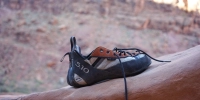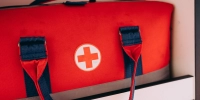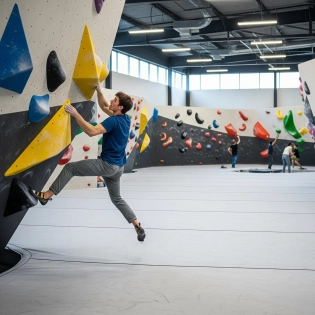







Climbers Point
Bouldering.
Boulders are the short routes that require crash pads if climbing outdoors. Indoor gyms have certain types of mattresses for falling on.
Rock climbing on higher walls without gear, including a rope and harness, is called free solo. It is the most dangerous form of climbing as you are climbing above safe heights with no protection.
Climbing shoes should be tight, but not painful. It is important to also differentiate between pain and discomfort, as climbing shoes are not comfortable, but should also not cause pain.
With that said, there can be slight amounts of pain when climbing in new climbing shoes, especially for new climbers. This is because climbing shoes tend to be pretty stiff out of the box, and it takes a while for them to break in, meaning, for them to get a little bit softer and to stretch a little bit.
For new climbers this will be felt a little bit more since they are not used to climbing shoes in general and to the tightness of them.
To know how tight your shoes should be, just keep in mind the reason the shoes need to be tight in the first place, which is to help improve your performance.
If you are a beginner climber, this means that you do not need very tight shoes, since the routes you will be climbing do not require a high level of precision. You will most likely not be standing on tiny foot holds that require you to be precise and to trust your feet. You will also not be using your heel to the extent that it must be very tight.
If you are a more advanced climber, then understand what you are expecting from your shoes. They should be tight enough to be able to allow you to stand on tiny foot holds, to trust your feet, and for your heel to not move inside the shoe. This means that you will need a tighter climbing shoe than a beginner climber would need. Though, this does not mean that the shoe must be painful, it just needs to be a good fit for the shape of your foot, and tight enough that it will give you all of its benefits, but none of the pain (or as little as possible).
It is also important to understand that not all shoes fit all feet. Some climbing shoes, even when trying on larger sized shoes, will not fit your feet and will cause pain regardless of the shoe size. This is because climbing shoes have different shapes and features, so it is important to try on different shoes and to find the ones that fit the shape of your foot the best, and then to choose the correct size that will be tight enough for your needs, but also not so tight as it will cause you pain, preventing you from even climbing in them.
Another point worth mentioning: Don't size down just to size down!
Many climbers think that climbing shoes must be a certain size below their street shoe size, so they buy climbing shoes that are 2 or 4 sizes smaller (some even more!), and just climb through the pain. This is very bad practice as it can cause you to not only not want to climb due to the pain, but can also be very dangerous for your feet! Don't think about sizing down when trying on climbing shoes, just get the shoe that you feel the most comfortable in and that feels right. Some people go up in climbing shoe size from their street shoe size because it just feels the best for them and gives them the performance they are looking for.
You actually don't need prior upper body strength to start climbing. You will gain that strength as you climb.
Many people believe that to climb, you need to pull your whole body's weight with your arms, essentially doing pull-ups to get to the top of the route. This, though, is very far from the truth.
Think of rock climbing as climbing a ladder. You would not just pull yourself up a ladder with your hands, right? No, you would use your legs to push yourself up, and your hands to slightly pull, but mainly to balance/navigate yourself. The same logic applies to climbing, especially in the easier routes.
Beginner climbing routes tend to have large holds that are easy to grab on to and hold. These routes are essentially ladders, they usually go straight up. All you need to do is to climb them just like you would a ladder. Their purpose is to slowly get people used to the feeling of climbing, the shoes, and the holds. As the routes get harder, the holds get smaller and harder to hold, and the routes get technically and physically harder.
By the time you get to those harder routes, though, you will have built up the upper and lower body strength that would allow you to climb them. But for the easier routes, and for beginner climbers, you can just start climbing without worrying about having prior upper or lower body strength.
Rock climbing is one of the best sports for building grip strength, and also one of the fastest to show improvements.
The main muscles used in climbing are the forearms, which are the muscles used for gripping.
While different grips do use different muscles, climbing is a great overall grip strengthener.
Beginner climbers will probably see the greatest improvements to their grip strength as it will work muscles that normally are not used at the level that climbing utilizes them, and not in the same way.
As you get more experience and go up in the climbing difficulty grades, your grip will also strengthen. The more advanced routes require more grip and hand strength, so as long as you are climbing and progressing, your grip and hand strength should also be increasing.
On top of that, climbers also tend to do extra exercises for their grip and fingers to help them go up the grades quicker and easier, and to improve their overall grip and hand strength. These additional exercises allow climbers to exercise specific grip styles, such as a more open hand grip, or a more closed hand grip. They also allow for different muscles in the forearms to be trained in a more isolated way.
Here are some exercises and tools climbers use to help strengthen their hands and grip:
- Hangboarding - Probably the most well known and common way of training fingers, hangboards usually have different edges with different depths and is used by just hanging from them from your fingertips. The smaller the edge, the more difficult it is. There are many exercises that can be done on the hang board, some with body weight, and some with weights, but they should all be done with caution as it is very easy to injure yourself on hangboards. Most people would say that you should not hangboard until you have climbed for at least 1 year, that is to make sure that your fingers and tendons are strong enough to actually handle the load hangboarding has on them.
- Pinch blocks - A great way to train grip strength for those small and large pinch holds on the wall, and a great general forearm strengthener, is the pinch block. This exercise uses a block, usually made of wood, and some weights that are attached to the bottom of it by a rope. All you do is punch the block and lift it for a few seconds off of the ground (depending on the exercise), and lower it back down.
- Crimp blocks - A sort of hybrid between the hangboard and the pinch block. This too is usually made of wood, and weights are attached to it. Just like the pinch block, depending on the exercise, you would grip this block with your fingertips, lift, hold, and then lower again. This exercise, much like the hangboard, needs to be done with a lot of caution as you can easily injure your fingers with this one too.
- Dead hangs - Probably the easiest and most available to do, all you need is a pull-up bar, or something to hang from, and then you just hang from it for as long as you can. You can add weight as you progress also.
- Finger curls using barbells or dumbbells - Not as common as the others, but still an option if you have some weight available to you. Don't add too much weight though as it could cause finger injuries.
Even without the additional exercises, though, climbing on its own is one of the best sports for increasing grip strength, maybe even the best, due to its heavy use of the fingers and forearms.
Rock climbing can actually be pretty heavy on the shoulders, as they are used in almost all climbing moves, so it makes sense that your shoulders will be strengthened from climbing.
Whether climbing will give you broad shoulders though is another thing. While it's true that climbing will strengthen your shoulders just like any other muscle strengthens due to training, the amount at which your shoulders will grow bigger doesn't depend just on climbing, but also on your body in general and if you also do other exercises and training.
It's very common to see skinny climbers who don't have much muscle mass climbing some of the harder, double-digit routes (v10+ for example), but, it's also common to see bulkier climbers also, some would say that their size comes only from climbing, some will say that it's a combination of climbing and weight training or other combinations.
So some very experienced climbers may not have that much muscle mass, while others may.
In the end, it depends on you and your body. If your goal is to get broader shoulders, then you could try adding weight training to your schedule, if you do not want broader shoulders, you can try just climbing and seeing what that does for you.
It's really very individual and requires experimentation to figure it out.
Rock climbing injuries can be quite common, but it depends on the climber and how well they listen to their bodies, and if they give their body the adequate amount of rest it requires.
It's quite common for new climbers to get injured to some extent due to them putting too much strain on their bodies and tendons, and due to them not resting enough and allowing their body and tendons to heal.
Even if you have been exercising in the gym, lifting weights, or doing other types of sports, climbing involves muscles that most people normally do not use, which means, they are not as strong as other muscles in the body. Due to this, new climbers often find "new" muscles in their body that they didn't know existed and never felt. It's because these muscles, that normally are not used, have been used more heavily during climbing, and since they are weaker than the other muscles to a greater degree, they are put under a much higher level of strain, resulting in possible overuse.
In addition to muscles, though, tendons also need time to adjust to the new strain that is put on them. Specifically, the tendons in the fingers and arms. A very common injury that occurs in new climbers are pulley injuries. One of the main reasons they happen is because new climbers tend to not know that these are in fact tendons, and not muscles. They are very different, and the amount of strain you can and should put on them is different, including the amount of rest they need.
Climbing involves more than just your muscles, which is why, adequate amount of rest is required in order to make sure that your body is healed, including muscles and tendons. Otherwise, it can be very easy to injure yourself.
Firstly, something many people don't actually realize is that the shoulders play a huge role in climbing. Many people think that climbing mainly uses your arms, back, and core, and that all of the other muscles are more like "supporters" for those main muscles.
Shoulders are heavily used in climbing, they are constantly engaged, and just as with other muscles, if you over use your shoulder muscles, they will hurt. If your shoulder muscles are generally weak, they will be more likely to hurt more than other muscles.
On top of that, climbing puts your body and shoulders in positions it may not be used to, causing your shoulders to put in extra effort in keeping your body stabilized and on the wall.
While climbing, our hands are mostly above our heads, or at head-height. This position, in addition to the heavy load they must bear (sometimes your body weight is held largely with the help of your shoulders), can cause a lot of strain on your shoulders, especially in the overhead position which can cause pinching to occur, resulting in painful shoulders.
With time and with better technique and stronger shoulders, the pain felt in the shoulders should lessen. This does of course depend on how well you listen to your body and if you give it the correct amount of rest which it requires. If not, you will likely injure yourself much soon and much worse.
If the pain is serious, and you are having a difficult time with it even when not climbing, you should see a doctor to get it checked. I have had a lot of issues with my shoulders in the past due to previous unrelated injuries, and climbing actually amplified the pain until I started treating it better and resting better. Now, my shoulders have gotten much stronger and I feel almost no pain at all. So listening to your body is crucial.





